PONTIAC VIBE 2010 Owner's Guide
Manufacturer: PONTIAC, Model Year: 2010, Model line: VIBE, Model: PONTIAC VIBE 2010Pages: 318, PDF Size: 1.7 MB
Page 31 of 318
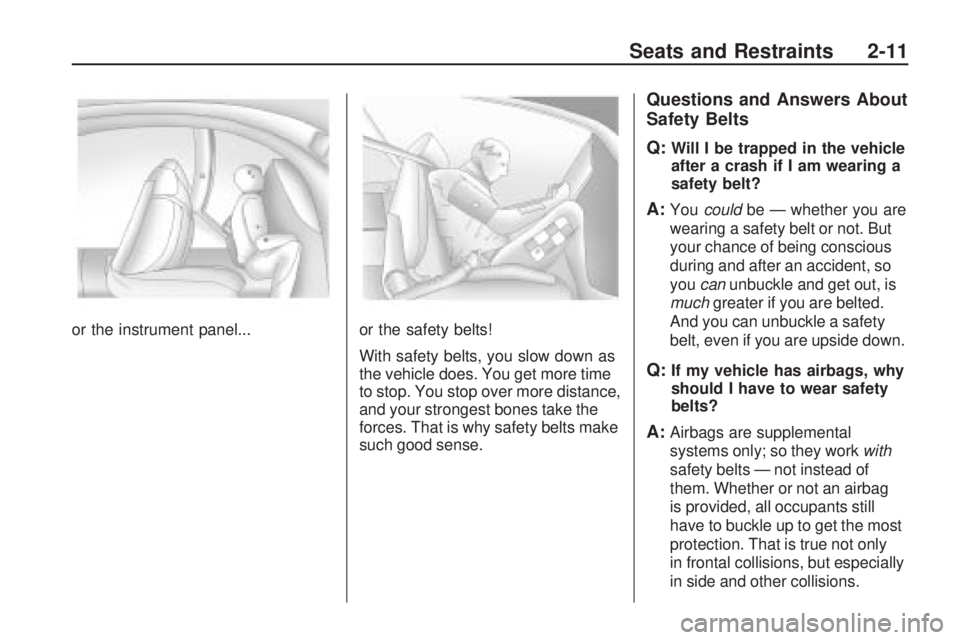
or the instrument panel...or the safety belts!
With safety belts, you slow down as
the vehicle does. You get more time
to stop. You stop over more distance,
and your strongest bones take the
forces. That is why safety belts make
such good sense.
Questions and Answers About
Safety Belts
Q:
Will I be trapped in the vehicle
after a crash if I am wearing a
safety belt?
A:You could be — whether you are
wearing a safety belt or not. But
your chance of being conscious
during and after an accident, so
you canunbuckle and get out, is
much greater if you are belted.
And you can unbuckle a safety
belt, even if you are upside down.
Q:If my vehicle has airbags, why
should I have to wear safety
belts?
A:Airbags are supplemental
systems only; so they work with
safety belts — not instead of
them. Whether or not an airbag
is provided, all occupants still
have to buckle up to get the most
protection. That is true not only
in frontal collisions, but especially
in side and other collisions.
Seats and Restraints 2-11
Page 32 of 318
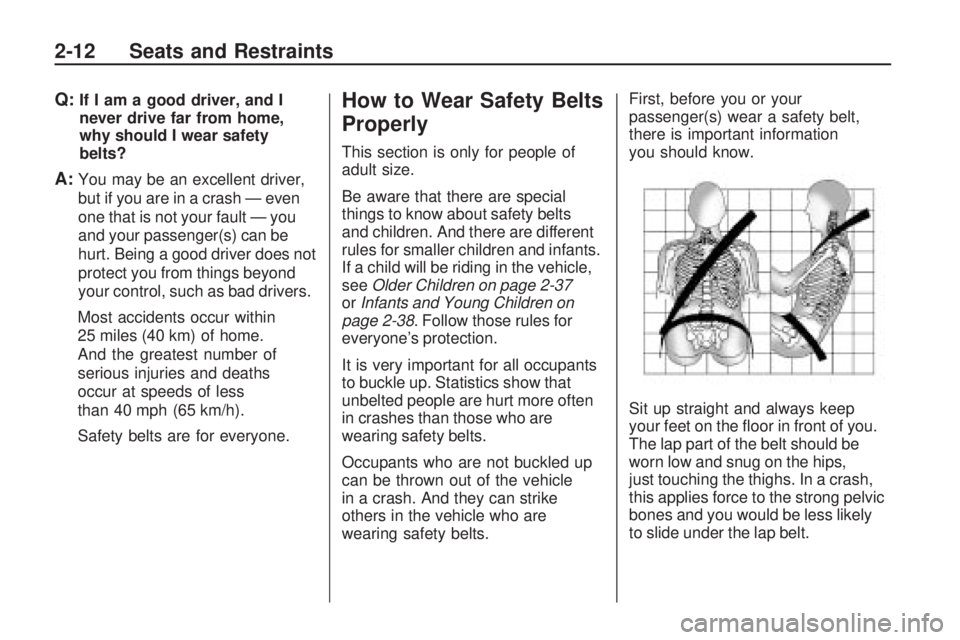
Q:If I am a good driver, and I
never drive far from home,
why should I wear safety
belts?
A:You may be an excellent driver,
but if you are in a crash — even
one that is not your fault — you
and your passenger(s) can be
hurt. Being a good driver does not
protect you from things beyond
your control, such as bad drivers.
Most accidents occur within
25 miles (40 km) of home.
And the greatest number of
serious injuries and deaths
occur at speeds of less
than 40 mph (65 km/h).
Safety belts are for everyone.
How to Wear Safety Belts
Properly
This section is only for people of
adult size.
Be aware that there are special
things to know about safety belts
and children. And there are different
rules for smaller children and infants.
If a child will be riding in the vehicle,
see Older Children on page 2-37
or Infants and Young Children on
page 2-38. Follow those rules for
everyone’s protection.
It is very important for all occupants
to buckle up. Statistics show that
unbelted people are hurt more often
in crashes than those who are
wearing safety belts.
Occupants who are not buckled up
can be thrown out of the vehicle
in a crash. And they can strike
others in the vehicle who are
wearing safety belts. First, before you or your
passenger(s) wear a safety belt,
there is important information
you should know.
Sit up straight and always keep
your feet on the floor in front of you.
The lap part of the belt should be
worn low and snug on the hips,
just touching the thighs. In a crash,
this applies force to the strong pelvic
bones and you would be less likely
to slide under the lap belt.
2-12 Seats and Restraints
Page 33 of 318
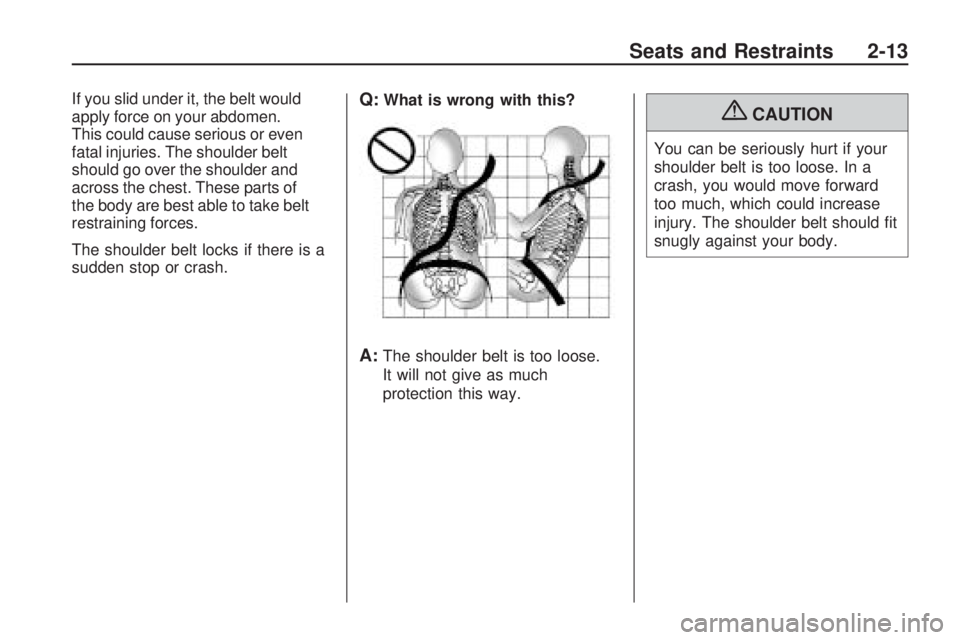
If you slid under it, the belt would
apply force on your abdomen.
This could cause serious or even
fatal injuries. The shoulder belt
should go over the shoulder and
across the chest. These parts of
the body are best able to take belt
restraining forces.
The shoulder belt locks if there is a
sudden stop or crash.Q:What is wrong with this?
A:The shoulder belt is too loose.
It will not give as much
protection this way.
{CAUTION
You can be seriously hurt if your
shoulder belt is too loose. In a
crash, you would move forward
too much, which could increase
injury. The shoulder belt should fit
snugly against your body.
Seats and Restraints 2-13
Page 34 of 318
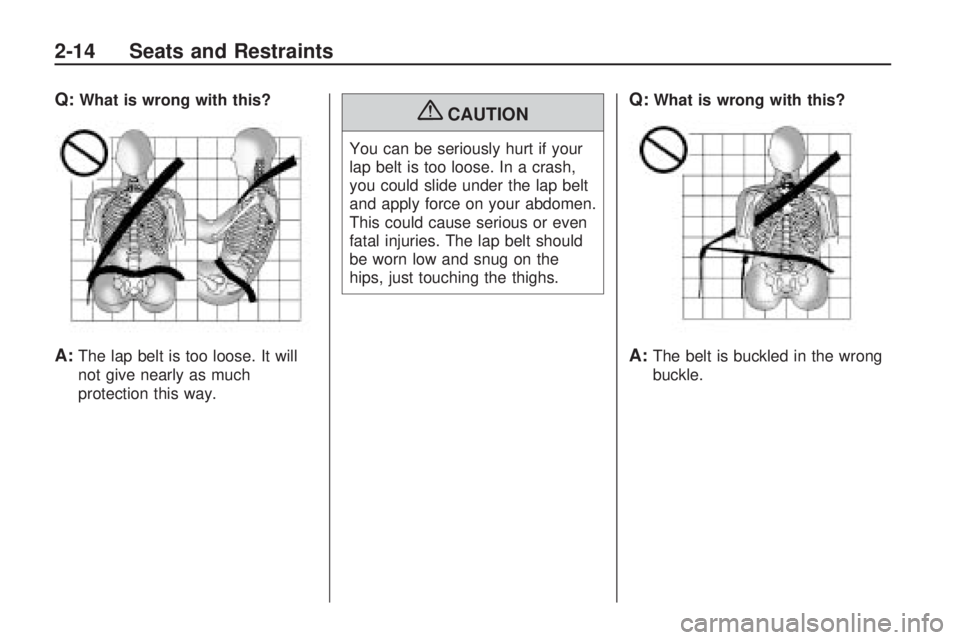
Q:What is wrong with this?
A:The lap belt is too loose. It will
not give nearly as much
protection this way.
{CAUTION
You can be seriously hurt if your
lap belt is too loose. In a crash,
you could slide under the lap belt
and apply force on your abdomen.
This could cause serious or even
fatal injuries. The lap belt should
be worn low and snug on the
hips, just touching the thighs.
Q:What is wrong with this?
A:The belt is buckled in the wrong
buckle.
2-14 Seats and Restraints
Page 35 of 318
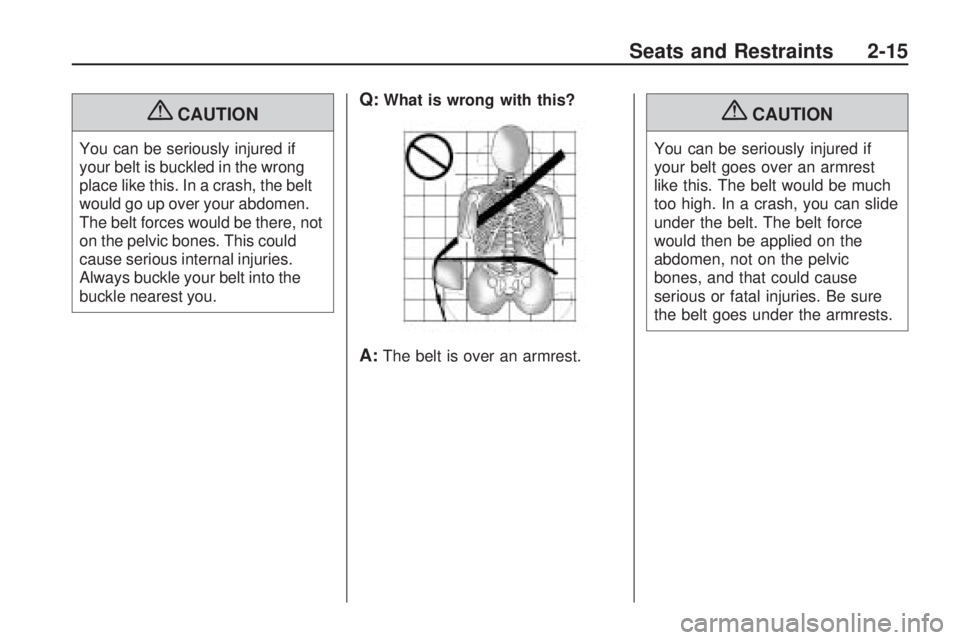
{CAUTION
You can be seriously injured if
your belt is buckled in the wrong
place like this. In a crash, the belt
would go up over your abdomen.
The belt forces would be there, not
on the pelvic bones. This could
cause serious internal injuries.
Always buckle your belt into the
buckle nearest you.
Q:What is wrong with this?
A:The belt is over an armrest.
{CAUTION
You can be seriously injured if
your belt goes over an armrest
like this. The belt would be much
too high. In a crash, you can slide
under the belt. The belt force
would then be applied on the
abdomen, not on the pelvic
bones, and that could cause
serious or fatal injuries. Be sure
the belt goes under the armrests.
Seats and Restraints 2-15
Page 36 of 318
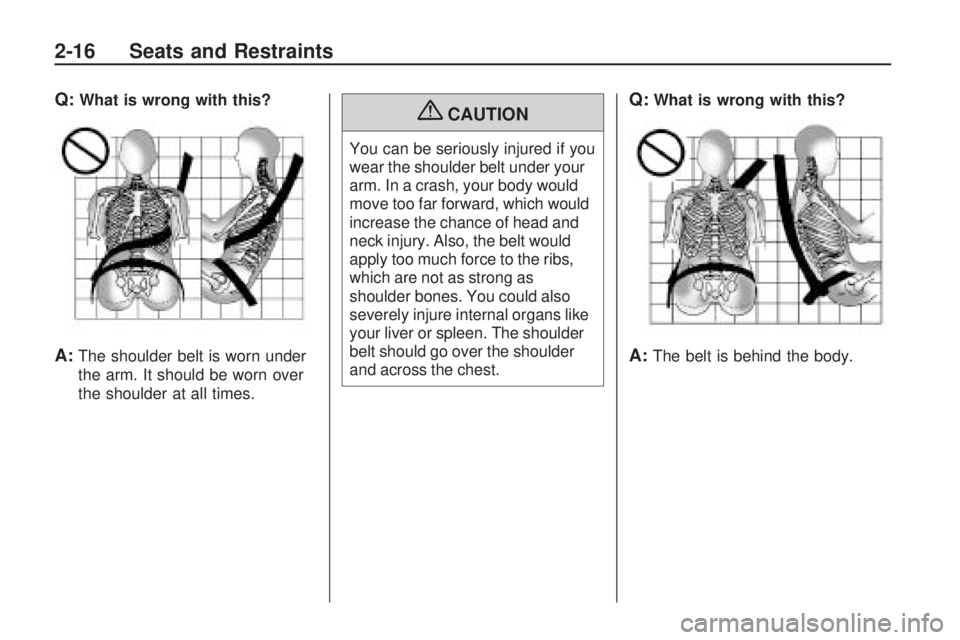
Q:What is wrong with this?
A:The shoulder belt is worn under
the arm. It should be worn over
the shoulder at all times.
{CAUTION
You can be seriously injured if you
wear the shoulder belt under your
arm. In a crash, your body would
move too far forward, which would
increase the chance of head and
neck injury. Also, the belt would
apply too much force to the ribs,
which are not as strong as
shoulder bones. You could also
severely injure internal organs like
your liver or spleen. The shoulder
belt should go over the shoulder
and across the chest.
Q:What is wrong with this?
A:The belt is behind the body.
2-16 Seats and Restraints
Page 37 of 318
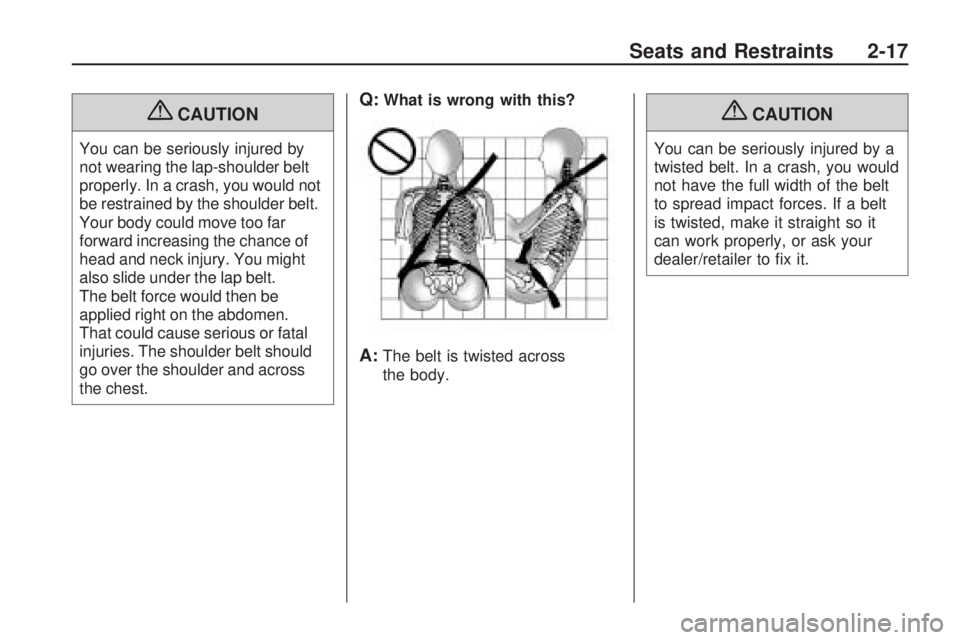
{CAUTION
You can be seriously injured by
not wearing the lap-shoulder belt
properly. In a crash, you would not
be restrained by the shoulder belt.
Your body could move too far
forward increasing the chance of
head and neck injury. You might
also slide under the lap belt.
The belt force would then be
applied right on the abdomen.
That could cause serious or fatal
injuries. The shoulder belt should
go over the shoulder and across
the chest.
Q:What is wrong with this?
A:The belt is twisted across
the body.
{CAUTION
You can be seriously injured by a
twisted belt. In a crash, you would
not have the full width of the belt
to spread impact forces. If a belt
is twisted, make it straight so it
can work properly, or ask your
dealer/retailer to fix it.
Seats and Restraints 2-17
Page 38 of 318
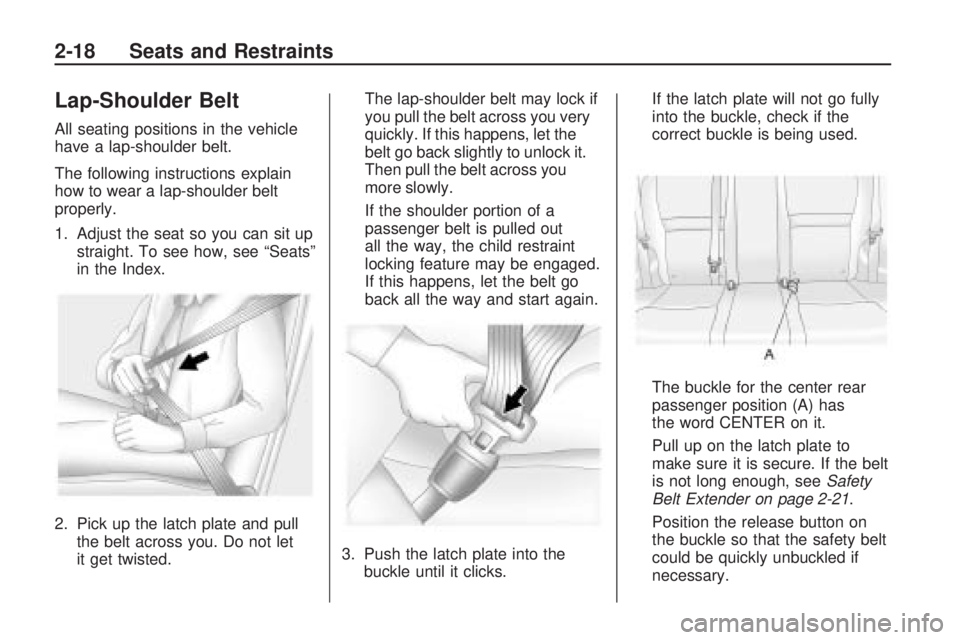
Lap-Shoulder Belt
All seating positions in the vehicle
have a lap-shoulder belt.
The following instructions explain
how to wear a lap-shoulder belt
properly.
1. Adjust the seat so you can sit upstraight. To see how, see “Seats”
in the Index.
2. Pick up the latch plate and pull the belt across you. Do not let
it get twisted. The lap-shoulder belt may lock if
you pull the belt across you very
quickly. If this happens, let the
belt go back slightly to unlock it.
Then pull the belt across you
more slowly.
If the shoulder portion of a
passenger belt is pulled out
all the way, the child restraint
locking feature may be engaged.
If this happens, let the belt go
back all the way and start again.
3. Push the latch plate into the buckle until it clicks. If the latch plate will not go fully
into the buckle, check if the
correct buckle is being used.
The buckle for the center rear
passenger position (A) has
the word CENTER on it.
Pull up on the latch plate to
make sure it is secure. If the belt
is not long enough, see
Safety
Belt Extender on page 2-21 .
Position the release button on
the buckle so that the safety belt
could be quickly unbuckled if
necessary.
2-18 Seats and Restraints
Page 39 of 318
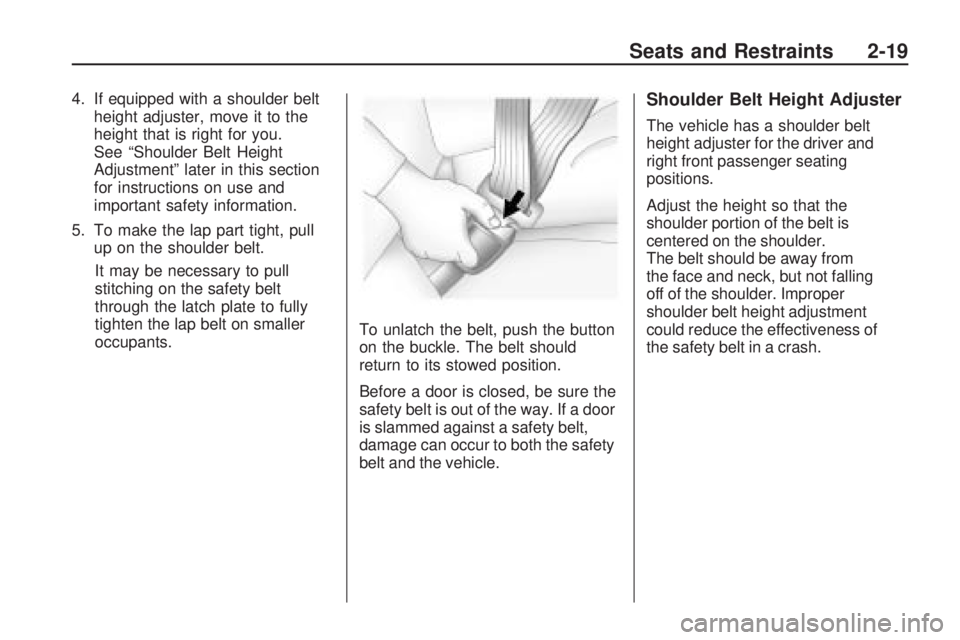
4. If equipped with a shoulder beltheight adjuster, move it to the
height that is right for you.
See “Shoulder Belt Height
Adjustment” later in this section
for instructions on use and
important safety information.
5. To make the lap part tight, pull up on the shoulder belt.
It may be necessary to pull
stitching on the safety belt
through the latch plate to fully
tighten the lap belt on smaller
occupants. To unlatch the belt, push the button
on the buckle. The belt should
return to its stowed position.
Before a door is closed, be sure the
safety belt is out of the way. If a door
is slammed against a safety belt,
damage can occur to both the safety
belt and the vehicle.Shoulder Belt Height Adjuster
The vehicle has a shoulder belt
height adjuster for the driver and
right front passenger seating
positions.
Adjust the height so that the
shoulder portion of the belt is
centered on the shoulder.
The belt should be away from
the face and neck, but not falling
off of the shoulder. Improper
shoulder belt height adjustment
could reduce the effectiveness of
the safety belt in a crash.
Seats and Restraints 2-19
Page 40 of 318
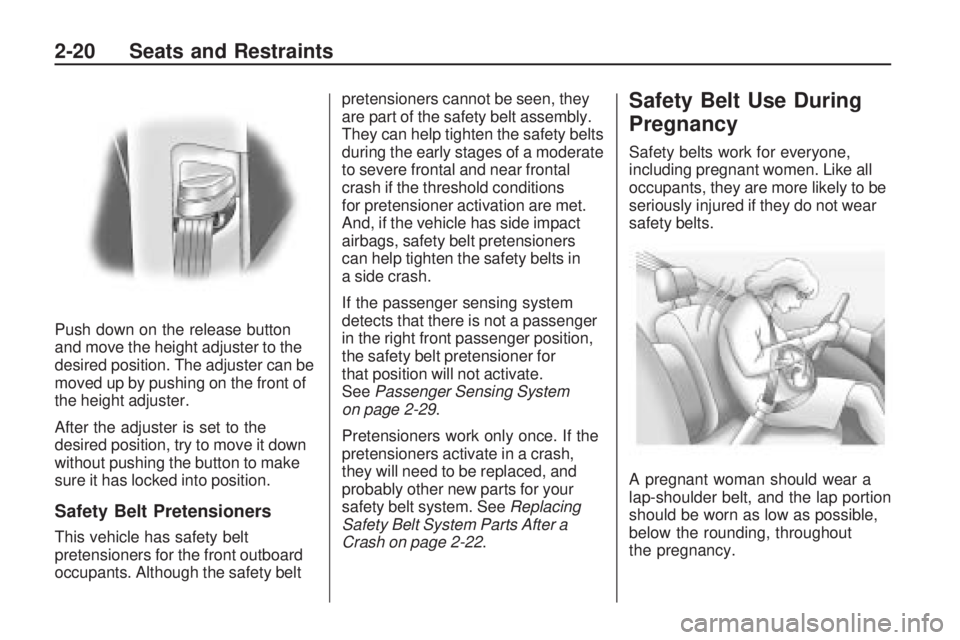
Push down on the release button
and move the height adjuster to the
desired position. The adjuster can be
moved up by pushing on the front of
the height adjuster.
After the adjuster is set to the
desired position, try to move it down
without pushing the button to make
sure it has locked into position.
Safety Belt Pretensioners
This vehicle has safety belt
pretensioners for the front outboard
occupants. Although the safety beltpretensioners cannot be seen, they
are part of the safety belt assembly.
They can help tighten the safety belts
during the early stages of a moderate
to severe frontal and near frontal
crash if the threshold conditions
for pretensioner activation are met.
And, if the vehicle has side impact
airbags, safety belt pretensioners
can help tighten the safety belts in
a side crash.
If the passenger sensing system
detects that there is not a passenger
in the right front passenger position,
the safety belt pretensioner for
that position will not activate.
See
Passenger Sensing System
on page 2-29.
Pretensioners work only once. If the
pretensioners activate in a crash,
they will need to be replaced, and
probably other new parts for your
safety belt system. See Replacing
Safety Belt System Parts After a
Crash on page 2-22.
Safety Belt Use During
Pregnancy
Safety belts work for everyone,
including pregnant women. Like all
occupants, they are more likely to be
seriously injured if they do not wear
safety belts.
A pregnant woman should wear a
lap-shoulder belt, and the lap portion
should be worn as low as possible,
below the rounding, throughout
the pregnancy.
2-20 Seats and Restraints